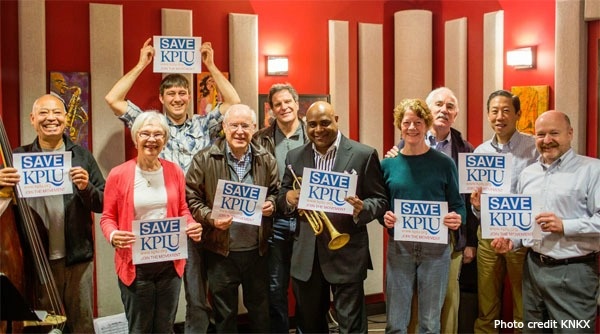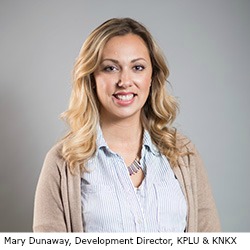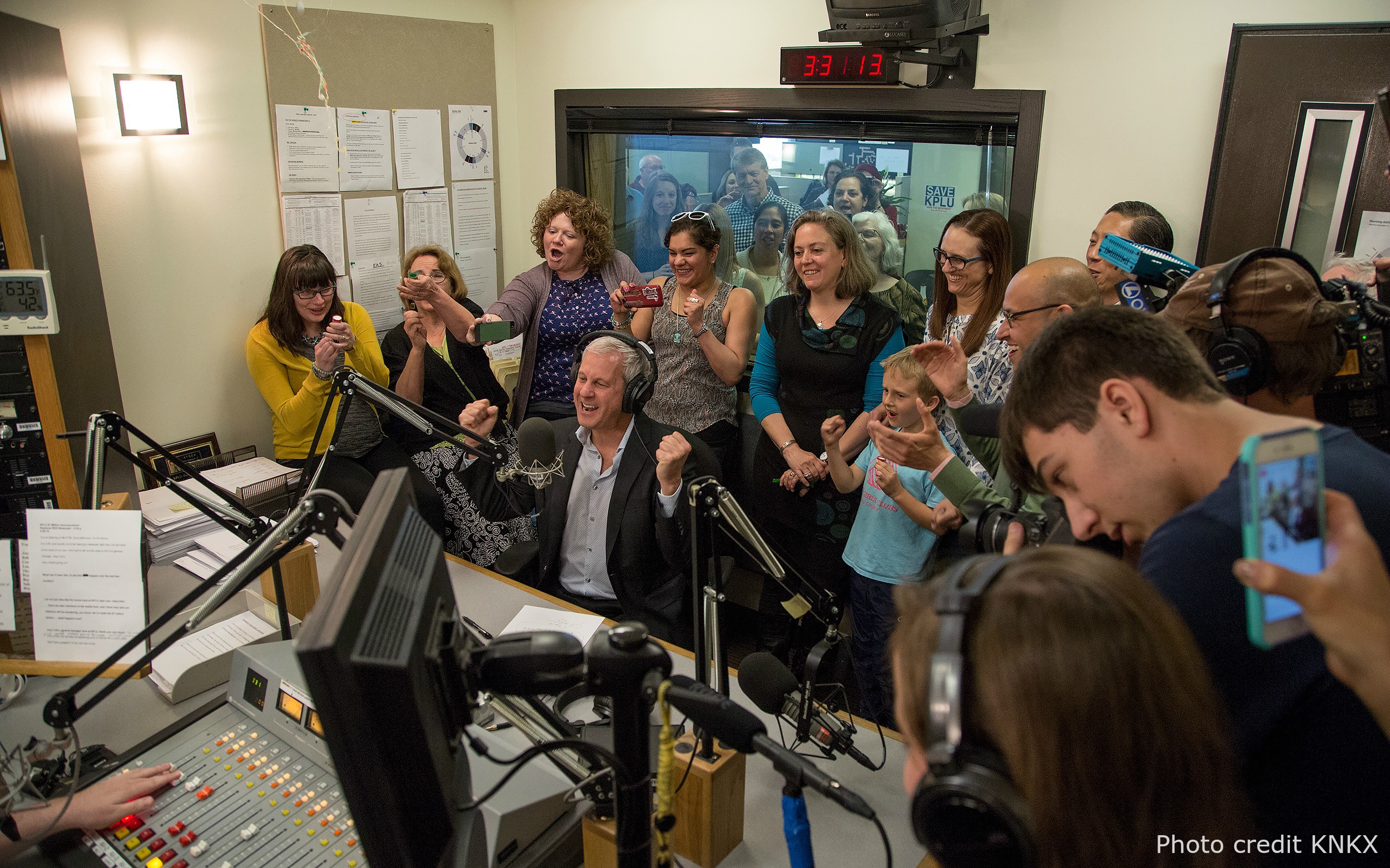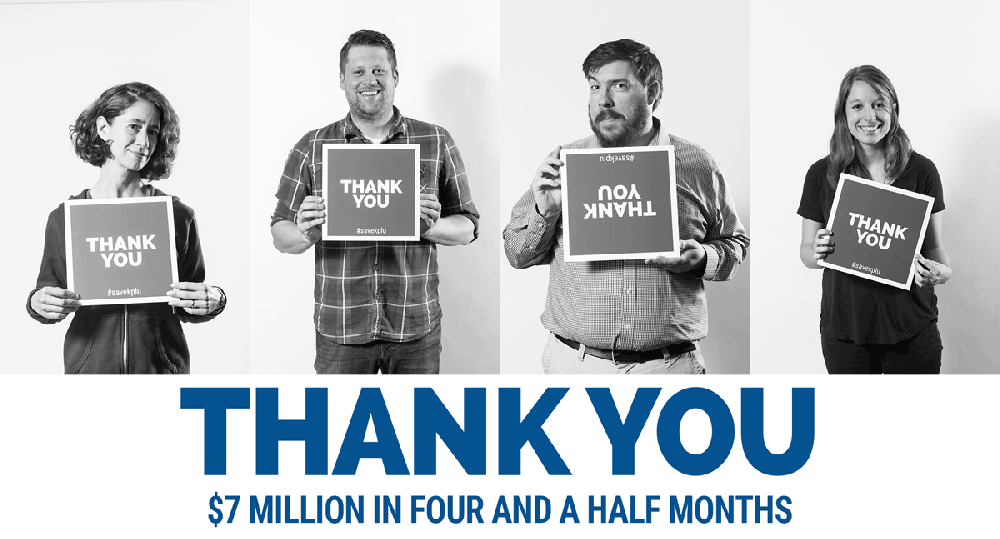Related Articles
Subscribe to the Greater Public newsletter to stay updated.
This site is protected by reCAPTCHA and the Google Privacy Policy and Terms of Service apply.

Interview and editing by Melanie Coulson
In November of 2015, Pacific Lutheran University announced plans to sell KPLU, its news/jazz-format station based in Tacoma, Wash., to the University of Washington, which operated rival station KUOW.
Less than seven months later, station employees and supporters achieved the unlikely feat of buying the license themselves in order to continue operating the station.
We talked to Mary Dunaway, the station’s development director, to understand how her development team and station supporters raised enough money to make public radio history.
Before they learned of the sale, KPLU leaders had reason to feel vulnerable about the station’s future. Its university was beset by enrollment troubles and staff reductions. A year earlier, the school hired new leadership which didn’t seem to inherently understand the station’s value. Still, disbanding KPLU altogether didn’t appear to be a likely outcome.
When the sale was announced, it was revealed that license-holder Pacific Lutheran University had been in negotiation with the University of Washington for 10 months. Station staff and supporters were shocked.
Of course, there was no communication plan for donors.
 Dunaway says they really had no choice but to be up-front with donors; to reveal what they knew and what they didn’t know.
Dunaway says they really had no choice but to be up-front with donors; to reveal what they knew and what they didn’t know.
“We didn’t have the option of creating a plan. We just started communicating,” Dunaway recalls. “We said, ‘Right now, what we understand is that we will be sold. We don’t know the timeline. We can only speculate as to why; the university issued a statement saying it’s what is best for the public media landscape. If you wish to voice any grievances, here’s how to share them with the university.’”
Many donors, including several major donors, felt that transferring ownership of the station didn’t honor the spirit and intent of their gifts to support public media at KPLU, though it was within the university’s legal right to sell. Public outcry began to mount, and station staff marshaled the feedback they received from donors toward proper channels within the two universities’ leadership teams.
Strong opposition also came from the members of KPLU’s Community Advisory Council, the station’s only independent board. This group emerged right away as a crucial ally in the fight to save the station. KPLU’s leadership and development staff had wisely cultivated the body over time. It was filled with passionate, engaged supporters who were also influential in the community.
About a month after the sale had been announced, against a backdrop of sustained local media attention toward the issue, the university and KUOW jointly declared that the community would be given the opportunity to buy the KPLU license. The price tag was a matching offer of $7 million in cash up front, and $1 million in underwriting to Pacific Lutheran University over 10 years. The deadline was June, 30, 2016, just six months away.
Raising $7 million in cash over six months with no advanced planning may be among the harder goals ever taken on by a public media station. Turns out, there were obstacles KPLU had to clear before a single gift could come in the door.
Fundraising for KPLU had to stop right away. The station might not exist in six months, so accepting donations would be unethical. Instead, a separate 501(c)3 had to be formed in order to raise money to save the station. So, they needed lawyers. And lawyers required money. They filed for federal and state licensing, formed a board of directors, and created new bank accounts.
“We identified our top five to ten donors,” Dunaway remembers. “In our early meetings with them, we told them of our plans to launch a campaign [to raise the money to buy the station]. We only asked that they commit to helping us through the process. Our promise to them was that we’d share everything as plans developed.”
One of the donors offered a six-figure gift to kick off the campaign. It was then that Dunaway and her colleagues learned that the station wasn’t entitled to use its reserves to operate the campaign as they’d hoped. KPLU’s budget was controlled by the university, which was using the reserves to fund station operations for the next six months. They had to find money to run the campaign — money that couldn’t be given back if they were unsuccessful.
“We realized very quickly, the campaign was broke,” Dunaway says. “We had to go back to the donor and say, ‘Thank you for your amazing support. Here are the initial expenses we plan to incur. Are you open to having your gift be nonrefundable?’”
The donor said yes.
Around the same time, a KPLU supporter who worked as a complex project planner stepped forward to help organize workflows and timelines for the myriad operational tasks that loomed ahead. Under his guidance, station leaders identified owners and major milestones for each area that needed to move forward: legal, regulatory, finance, small gifts, major gifts, marketing, and events.
Dunaway explains that, once these operations were triaged and assigned to various teams, the station could harness the truly remarkable grassroots effort that was emerging.
“When supporters stepped forward to say, ‘I’m a lawyer. I’m a designer. I can throw you a house party to raise money. I can design your materials.’ We could take advantage of those offers. We’d say, ‘That’s great. Talk to Brenda. Talk to Matt.’ We had a workflow that let us put their offers to use.”
By mid-January, the campaign had launched. Dunaway’s team started communicating with supporters via the KPLU email list. (They first offered the opportunity to opt out; only a handful of recipients did.) They began tracking progress on a website as well.
To make their case, they outlined what could be lost if KPLU were to be shuttered, as well as what made the station strong.
“Remember, this is not an on-air campaign,” Dunaway points out. “We were only allowed to have 20-second Public Service Announcements on KPLU’s airwaves.”
Their main communication channel was the email updates they sent every Monday, with or without big news.
“Even if we stalled, we could detail the events we had for the week,” says Dunaway. “We’d share fundraising activities, calls to action, requests for help. It gave us the feeling of forward-momentum.”
KPLU’s 50-year history, along with the loyalty donors felt toward the station, helped the campaign gain traction quickly. About 75% of the station’s membership file had been active for more than 15 years. Supporters had been acknowledged and cultivated over time, and had a strong sense of the station’s impact.
“It wasn’t an ivory tower,” Dunaway explains. “People said over and over that it felt like a family. [Donors] felt they could call us and tell us their grievances. They could even pop in for a tour.”
The station’s broadcast area extended across the entire western half of the state, so the staff organized regional community meetings to inform and connect with the large numbers of supporters that were mobilizing on their behalf.
“And at the end of each meeting,” Dunaway recalls, “We’d say, ‘We need your help. The scope of this is beyond us.’ We directed them to download the Save KPLU toolkit and asked them to make a gift, or host a party in their home to generate support. We promised to show up to every party with someone from the development staff or an on-air personality. We divvied the events up amongst the staff. We were going to events every night of the week.”
Over six months, staff attended over 100 events put on by members of the community. Some raised $1,000 and some raised $10,000, but all raised crucial awareness and an investment in the station’s future.
Dunaway and her staff worked 50-60 hours a week and joked about aging years in those six months.
“We were exhausted basket-cases,” she admits. “But then you’d go to a community meeting and your heart would swell. You were reminded that it was worth it.”
Maintaining staff morale felt precarious at times, but also fueled their resolve.
“We all decided we were going to commit to this. We in management approached the staff and said, ‘We are committing to stay. Let’s do this together.’ It was a once-in-a-lifetime opportunity to save a public media station. To abandon that felt unimaginable. In all, we lost two staff members, one of whom has since returned.”
An anonymous $200,000 matching gift early-on became the basis for the major giving strategy for the duration of the campaign. The development team would pool intent for major gifts that formed a ladder of matching challenges. After that first anonymous gift, they pooled another $500,000 matching challenge. It was met within two weeks.
But it wasn’t until early May that the effort seemed like it really might succeed. Seattle observed its annual “Give Big” event, a region-wide day of nonprofit giving. The station generally raised $80,000 in connection with the event and they hoped to double that with heavy promotion as part of the Save KPLU campaign.
After 24 hours they’d raised $1.3 million, exceeding the GiveBig record for a single day of fundraising by more than $1 million.
At that moment, with about two months left of the campaign, KPLU had raised $5.5 million.
The staff constructed its final matching challenge that would take them to their $7 million goal. It was met within seven days.
On May 26, 2016, donors were invited to tune in for the biggest announcement of the station’s history: KPLU had succeeded in raising $7 million in less than five months.
 KPLU General Manager Joey Cohn announces on-air that the Save KPLU campaign has reached its goal.
KPLU General Manager Joey Cohn announces on-air that the Save KPLU campaign has reached its goal.
In the end, 24,000 supporters would raise $8 million dollars with an average gift of just over $330. A campaign of this size is usually achieved with 80% major gifts and 20% smaller gifts. KPLU was saved by a grassroots effort made up of 70% small gifts. Less than a third of the contributions were major gifts of $10,000 or more.
The station became independent on August 31, 2016.
The newly-named KNKX marked the first anniversary of reaching its goal last month. The past year has been the most successful fundraising year in the station’s history. Supporters didn’t stop giving to the campaign once their goal was reached. Instead, gifts continued to arrive at the station, allowing KNKX to build up 65% of the reserves that had existed the previous year under university leadership.
Perhaps most thrilling has been the message that Dunaway and her team have directed toward donors during each member drive over the past year:
You saved us. Thank you.


New to Greater Public? Create an account.